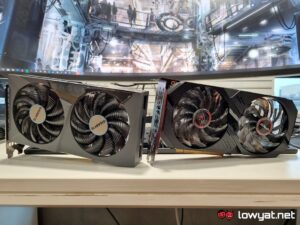NVIDIA GeForce RTX 3050 8GB Vs AMD Radeon RX 6500XT: Entry-Level Showdown 2022 Edition

Earlier in the year, both AMD and NVIDIA launched their respective entry-level graphics card simultaneously. Over on the side of team Red, we have the Radeon RX 6500XT, which rocks the lesser Navi 24 GPU, based of course on AMD’s 7nm RDNA2 GPU architecture. Over at NVIDIA’s corner, the GPU giant offers the world the GeForce RTX 3050, which is based on the brand’s most current 8nm Ampere architecture.
In this review, we’ll be taking a look at both cards in tandem, in order to see which of these entry-level graphics cards has the better performance-per-dollar ratio, and which doesn’t.
The Contenders

Because neither AMD nor NVIDIA has any reference designs for their entry-level cards, both GPU makers have kindly provided us with iterations of their respective GPUs from their respective AiB partners. For NVIDIA, the brand has given us a Gigabyte Eagle GeForce RTX 3050, while AMD provided us with an ASRock Phantom Gaming Radeon RX 6500XT.
I will be brief and won’t spend too much time here elaborating on the specifications of both cards, as I believe the table I have provided above should be self-explanatory. In summary, the RTX 3050, like its more powerful siblings, is based on NVIDIA’s current Ampere architecture, along with the same 8nm process node.





As for the 6500XT, the card’s GPU is the Navi 24 based on AMD’s RDNA2 architecture, but instead of the current 7nm process used in the upper echelons of the Radeon RX 6000 series, it is the first card whose GPU is made using the new 6nm die lithography. As an entry level offering, the GPU’s Infinity Cache is also the smallest application for a consumer-ready Radeon graphics card at 16MB.






As far as cooling shroud designs go, both the RTX 3050 and 6500XT in this showdown sport a dual-fan configuration, and both require one 8-pin PCIe power connector in order to run. Ports-wise, the RTX 3050 comes with two DisplayPort 1.4a ports and two HDMI 2.1 ports, while the 6500XT only has one of each, making it a card with limited display outputs.
The Testbed

At this stage, I should probably take a moment to address the elephant in the room: the discrepancy between the two cards. Yes, I am well and fully aware that the RTX 3050 has double the graphics memory of the 6500XT, but to reiterate, both these cards fall into the entry-level category and are being reviewed in that context.
To ensure that there are as few bottlenecks as possible, I will be using my current X570 testbed, and not Intel’s latest 12th generation Z690 chipset. The reasoning behind this is that the efficiency cores on the latest Alder Lake CPUs – otherwise known as the E-Cores – don’t actually play nice with a couple of game titles on the list. Well, that, and the issue between 12th generation Intel CPUs and the DRM in the games.

For that matter, I will be testing these cards on Windows 10 and not Windows 11 at this point. Having said that, rest assured I will be updating the system to the new OS in the near and immediate future. Oh, and for another matter, because these cards are tailored for the entry-level market, all game titles will be limited to Full HD resolution only.
The Benchmarks

Right off the bat, the difference between the RTX 3050 and 6500XT is like the sun and moon. Sure, the 6500XT is able to dance along with Team Green’s card, but that’s where the buck stops. With double the GDDR6 graphics memory and a suite of NVIDIA’s tried and tested performance enhancement features, the RTX 3050 has no problems outpacing the Red team’s card.
Even in titles like Control and Cyberpunk 2077, where ray-tracing is available and applicable, it is the RTX 3050 that emerges as the champion in the framerates war. Both, with ray-tracing turned on and off. Even in Borderlands 3, a title that is technically AMD-centric, the 6500XT has trouble maintaining its composure, with average frames in the game peaking at 35 fps and only ever breaking past the 40 fps mark for brief moments in-game. Granted, the graphics preset on both cards were set at Medium for Cyberpunk 2077 but once again, these cards are for budget-minded gamers, so some management of expectations is required.











If there is one thing that the 6500XT has going for it, though, it would be that the card is actually pretty efficient in its ability to manage power consumption, even when it is being put through its paces. Likewise, the same can be said about its maximum sustained temperature when under load, however, I am going to have to chalk this one up to ASRock’s custom cooling solution for the card.
Conclusion

I’m going to cut to the chase here: as evidenced by the benchmarks, both synthetic and real-world, it is obvious that NVIDIA’s GeForce RTX 3050 is the clear winner here, effectively outpacing AMD’s Radeon RX 6500XT by a very long and steady mile. Seriously, in virtually every one of our benchmark titles, it is NVIDIA’s entry-level offering that is consistently laying the proverbial smackdown on the competition.
And while the ASRock Phantom Gaming Radeon RX 6500XT is considerably cheaper than the Gigabyte Eagle GeForce RTX 3050 – the 6500XT retails at RM1299 while the RTX 3050 is priced at RM1719 – I would still advocate for the consumer to fork out the additional RM420 for the entry-level NVIDIA GPU and the promise of higher frames, and at Full HD resolution.
Point: NVIDIA.
Photography by John Law.




















The post NVIDIA GeForce RTX 3050 8GB Vs AMD Radeon RX 6500XT: Entry-Level Showdown 2022 Edition appeared first on Lowyat.NET.
